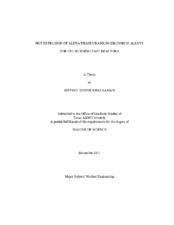| dc.contributor.advisor | McDeavitt, Sean M. | |
| dc.creator | Hausaman, Jeffrey Stephen | |
| dc.date.accessioned | 2012-02-14T22:20:37Z | |
| dc.date.accessioned | 2012-02-16T16:18:48Z | |
| dc.date.available | 2012-02-14T22:20:37Z | |
| dc.date.available | 2012-02-16T16:18:48Z | |
| dc.date.created | 2011-12 | |
| dc.date.issued | 2012-02-14 | |
| dc.date.submitted | December 2011 | |
| dc.identifier.uri | https://hdl.handle.net/1969.1/ETD-TAMU-2011-12-10609 | |
| dc.description.abstract | The development of fast reactor systems capable of burning recycled transuranic (TRU) isotopes has been underway for decades at various levels of activity. These systems could significantly alleviate nuclear waste storage liabilities by consuming the long-lived isotopes of plutonium (Pu), neptunium (Np), americium (Am), and curium (Cm). The fabrication of metal fuel alloys by melt casting pins containing the volatile elements Am and Np has been a major challenge due to their low vapor pressures; initial trials demonstrated significant losses during the casting process.
A low temperature hot extrusion process was explored as a potential method to fabricate uranium-zirconium fuel alloys containing the TRU isotopes. The advantage of extrusion is that metal powders may be mixed and enclosed in process canisters to produce the desired composition and contain volatile components. Uranium powder was produced for the extrusion process by utilizing a hydride-dehydride process that was developed in conjunction with uranium alloy sintering studies. The extrusions occurred at 600 degrees C and utilized a hydraulic press capable of 450,000 N (50 tons) of force.
Magnesium (Mg) metal was used as a surrogate metal for Pu and Am because of its low melting point (648 degrees C) and relatively high vapor pressure (0.2 atm at 725 degrees C). Samples containing U, Zr, and Mg powder were prepared in an inert atmosphere glovebox using copper canisters and extruded at 600 degrees C. The successful products of the extrusion method were characterized using thermal analysis with a differential scanning calorimeter as well as image and x-ray analysis utilizing an electron microprobe. The analysis showed that upon fabrication the matrix of the extruded metal alloy is completely heterogeneous with no mixing of the metal particle constituents. Further heat treating upon this alloy allows these different materials to interdiffuse and form mixed uraniumz-irconium phases with varying types of microstructures. Image and x-ray analysis showed that the magnesium surrogate present in a sample was retained with little evidence of losses due to vaporization. | en |
| dc.format.mimetype | application/pdf | |
| dc.language.iso | en_US | |
| dc.subject | Extrusion | en |
| dc.subject | Uranium | en |
| dc.subject | Zirconium | en |
| dc.subject | Transuranics | en |
| dc.title | Hot Extrusion of Alpha Phase Uranium-Zirconium Alloys for TRU Burning Fast Reactors | en |
| dc.type | Thesis | en |
| thesis.degree.department | Nuclear Engineering | en |
| thesis.degree.discipline | Nuclear Engineering | en |
| thesis.degree.grantor | Texas A&M University | en |
| thesis.degree.name | Master of Science | en |
| thesis.degree.level | Masters | en |
| dc.contributor.committeeMember | Charlton, William | |
| dc.contributor.committeeMember | Shao, Lin | |
| dc.contributor.committeeMember | Grunlan, Jaime | |
| dc.type.genre | thesis | en |
| dc.type.material | text | en |


